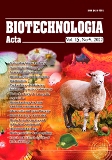ISSN 2410-7751 (Print)
ISSN 2410-776X (Online)

Biotechnologia Acta V. 15, No. 4, 2022
P. 8-10. Bibliography 7, Engl.
UDC: 571.27
https://doi.org/10.15407/biotech15.04.008
CIRCADIAN VARIATION IN FUNCTIONAL POLARIZATION OF MURINE PERITONEAL MACROPHAGES
R. Dovhyi, M. Pasichnichenko, A. Marynchenko, Zh. Oliynyk, A. Nefodova, M. Rudyk, L. Skivka
Taras Shevchenko National University of Kyiv, Ukraine
Aim. This study aimed to investigate the circadian rhythm of the murine peritoneal macrophage (PM) metabolic profile.
Methods. The metabolic profile of PM was characterized by phagocytic activity, reactive oxygen species (ROS) generation, and by the expression of phenotypic markers, associated with a pro- and anti-inflammatory metabolic shift. Phagocytosis of FITC-labeled inactivated Staphylococcus aureus, ROS generation, CD80, CD86, and CD206 expression were estimated by flow cytometry at a regular 4h interval over the daily light-dark cycle.
Results. The phagocytic index and percentage of ROS-producing PM were found to be lower in the resting phase (ZT4) as compared to the active phase. In contrast, the level of CD86 expression was the highest in the inactive phase (ZT8). There was also a statistically significant peak in the proportion of ROS-producing PM, as well as in the level of ROS production per cell at the time of awakening (ZT12). As opposed to ROS generation, ZT12 was characterized by the lowest level of cell-surface CD206 expression.
Conclusions. Our results indicate that there is a circadian rhythm in functional polarization of murine PM with an anti-inflammatory activation state in the resting phase in comparison to the active phase.
Key words: circadian rhythm, peritoneal macrophages, phagocytosis, reactive oxygen species, phenotypic polarization.
© Palladin Institute of Biochemistry of the National Academy of Sciences of Ukraine, 2022
References
1. Vieira E., Mirizio G. G., Barin G. R., de Andrade R. V., Nimer N. F. S., La Sala L. Clock Genes, Inflammation and the Immune System—Implications for Diabetes, Obesity and Neurodegenerative Diseases. Int. J. Mol. Sci. 2020, 21(24), 9743. https://doi.org/10.3390/ijms21249743
2. Liu T., Liu F., Peng L. W., Chang L., Jiang Y. M. The Peritoneal Macrophages in Inflammatory Diseases and Abdominal Cancers. Oncol Res. 2018, 26(5), 817–826. https://doi.org/10.3727/096504017x15130753659625
3. Timmons G. A., O’Siorain J. R., Kennedy O. D., Curtis A. M., Early J. O. Innate Rhythms: Clocks at the Center of Monocyte and Macrophage Function. Front. Immunol. 2020, 11, 1743. https://doi.org/10.3389/fimmu.2020.01743
4. Curtis A. M., Bellet M. M. Sassone-Corsi P., O’Neill L. A. J. Circadian Clock Proteins and Immunity. Immunity. 2014. 40(2), 178–186. https://doi.org/10.1016/j.immuni.2014.02.002
5. Kiessling S, Dubeau?Laram?e G, Ohm H, Labrecque N, Olivier M, Cermakian N. The circadian clock in immune cells controls the magnitude of Leishmania parasite infection. Sci Rep. 2017, 7(1): 10892. https://doi.org/10.1038/s41598-017-11297-8
6. Silver A. C., Arjona A., Walker W. E., Fikrig E. The circadian clock controls toll-like receptor 9-mediated innate and adaptive immunity. Immunity. 2012, 36, 251–261. https://doi.org/10.1016/j.immuni.2011.12.017
7. Wang L. X., Zhang S. X., Wu H. J., Rong X. L., Guo J. M2b macrophage polarization and its roles in diseases. J. Leukoc. Biol. 2019, 106, 345–358. https://doi.org/10.1002/JLB.3RU1018-378RR

